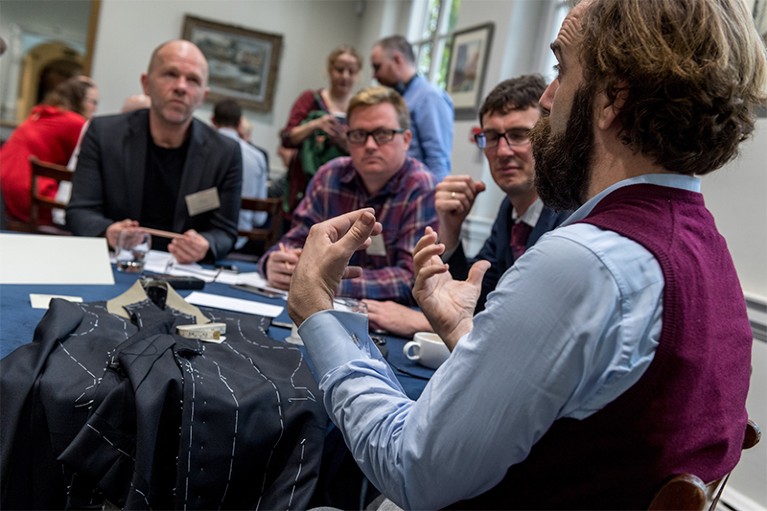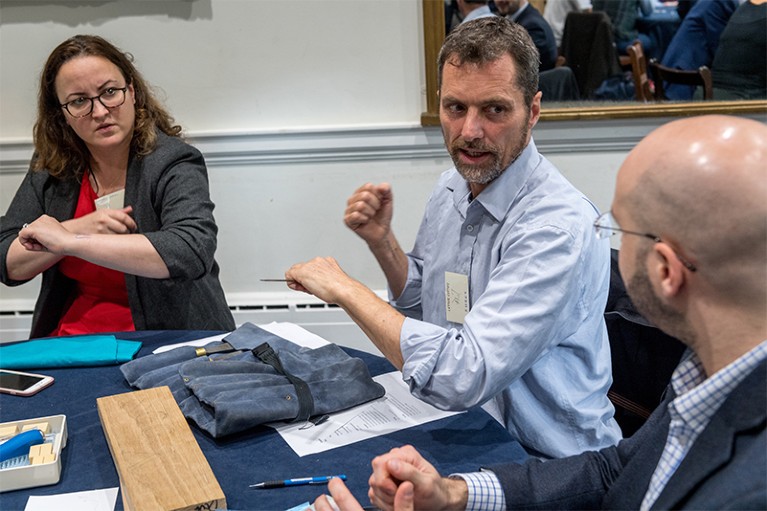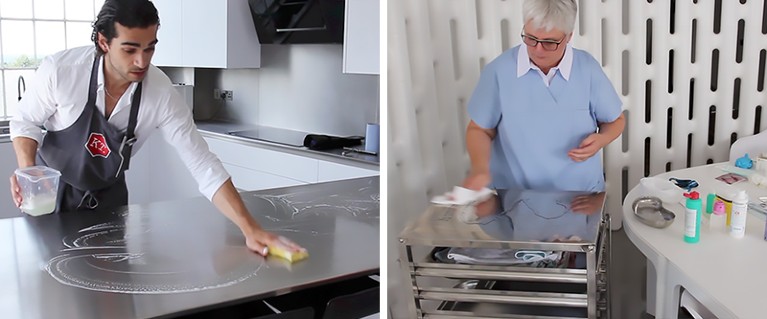Even shaking a sample, rather than stirring it, can change results. Why then, among the many reasons discussed for the reproducibility crisis, does lab practice not get more attention (see Nature 533, 452–454; 2016)?
Most science students enter university with years of screen time under their belts, but very little experimental experience. Indeed, many early-stage PhD students struggle with the transition from predetermined practicals to independent experimentation and design, where the ability to notice tiny departures from the expected might be crucial to discovery.
Some might not have ‘good hands’. Moreover, written accounts are notoriously open to interpretation: ‘add reagent X dropwise until the solution changes from red to yellow’ seethes with potential ambiguity. Laboratory knowing takes place at the intersection between materials, tools and a researcher’s body. Its rhythms differ from those of simply absorbing facts.
We — a surgeon, a research nurse and a synthetic chemist — looked beyond science to discover how people steeped in artistic skills might help to close this ‘haptic gap’, the deficit in skills of touch and object manipulation. We have found that craftspeople and performers can work fruitfully alongside scientists to address some of the challenges. We have also discovered striking similarities between the observational skills of an entomologist and an analytical chemist; the dexterity of a jeweller and a microsurgeon; the bodily awareness of a dancer and a space scientist; and the creative skills of a scientific glassblower, a reconstructive surgeon, a potter and a chef.

Tailor Joshua Byrne (far right) discusses time-critical working with (left to right) guitarist Petur Jonasson, toxicologist Toby Athersuch and vascular surgeon Colin Bicknell.Credit: Fergus Burnett/Imperial College London
For more than 20 years, R.K. has explored this landscape, building a network of experts from apparently unconnected domains to share insights for the lab or operating theatre. In October last year, that multidimensional collaboration led to the Art of Performing Science, a symposium at Imperial College London — funded by the UK Economic and Social Research Council — that has proved to be a powerful catalyst for further collaboration.
It was an intensely diverse grouping, drawing together more than 60 experts from Britain and the rest of Europe. Here were synthetic chemists, biologists, paediatric surgeons, radiologists, scientific glassblowers and instrument technicians; and social scientists from anthropologists to ethnographers. Here, too, were curators, keepers and conservators from major UK institutions, including London’s National Gallery and Victoria and Albert Museum; potters, taxidermists and stonecutters; and performers including musicians and dancers, as well as chefs and even an Olympic rower.
Unexpected parallels in practice emerged. Kathrin Altwegg, leader of the ROSINA instrument programme for the European Space Agency’s ROSETTA comet probe, and Imperial technician Paul Brown (who works on the agency’s 2020 Solar Orbiter initiative) revealed how space programmes demand close collaboration between experts in their disciplines. Ophthalmic anaesthetist Friedrich Lersch described how his fingers must ‘see’ layers of the eye to ensure that he finds the right plane for injection. He revealed that his past experience as an apprentice tailor has enabled the interpretation of subtle signals from materials. Conservators Charlotte Hubbard and Isabella Kocum found common ground with taxidermist Derek Frampton and dentist Flora Smyth Zahra; all must manipulate probes and forceps to restore fragile materials. Detailed observation and fine hand–eye coordination are centrally important in the lab, conservation room and artisan’s studio.

Hand surgeon Samantha Gallivan (left) and letter cutter Phil Surey use a gestural language as they talk to plastic surgeon Haz Sadideen.Credit: Fergus Burnett/Imperial College London
Better still, 12 months on, some of these encounters have led to practical solutions. Letter-carver Phil Surey and consultant hand surgeon Samantha Gallivan discovered a shared gestural language: both use chisels with hard materials, ‘listening’ to stone or bone as they make irreversible cuts with focused precision. Carvers, for instance, notice that when stone ‘gets tired’ through repeated hammering, it is at risk of fragmenting. Gallivan and fellow orthopaedic surgeon Malek Racy are now collaborating with stone-carver Nina Bilbey to find a way of developing such skills early in surgical training.
The parallels between chemistry and cooking were especially striking. Jozef Youssef — chef patron of London-based experimental gastronomical design studio Kitchen Theory — highlighted mise en place. This central culinary principle demands that each cook manage their own work space — knives here, ingredients there — to ensure that they can replicate dishes in the demanding setting of high-end restaurants. In labs, similar ways of working are expected but seldom articulated.

A chef and a wound-care nurse demonstrate mise en place, the art of managing their work spaces.Credit: Imperial College London and Berner Bildungszentrum Pflege
R.K., A.S. and Youssef have now launched the Chemical Kitchen, a three-year collaboration between chemistry and culinary students that will start in January 2019. Through a programme of graded tasks, undergraduate chemistry students at Imperial will experience the planning and precision of a professional kitchen. Whether making a soufflé or baking bread, ingredients must be weighed, combined and transformed through heat and pressure, every element rigorously controlled. Would-be chefs, in turn, will practise chemical procedures requiring similar precision, such as distillation or using a Schlenk vacuum line cooled to −50 °C to reproducibly form air-sensitive organometallic compounds. The aim is reciprocal illumination.
Systematic working, close noticing, dexterity, meticulousness and respect for materials and fellow workers all lie at the heart of successful, reproducible science. By examining laboratory ‘doing’ from unfamiliar perspectives, scientists could shed new light on — and hopefully begin to overcome — the reproducibility crisis.


 Discovery through doing
Discovery through doing




